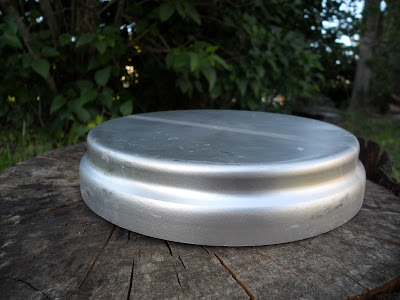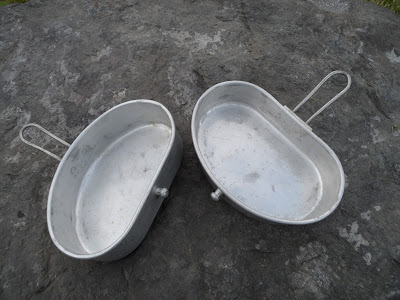Today we'll be taking a look at another new addition to the ever growing Mess Kit Collection.
This mess kit is a post-WW2 issue kit for the Czechoslovakian Army, known in Czech as the Československá lidová armáda, or CSLA. This style mess kit was produced and issued from the early 1950's all they way into the 2000's. I believe that the mess kit that I have is one of the more recently produced kits that was never issued.
From what I understand, these mess kits were first produced in the early 1950's, probably 1952. These early mess kits were made of tinned steel, and then later, the mess kits were produced in aluminum, sometime in the late 1950's or in 1960. The mess kits were only produced in aluminum after that time. The handles continued to be made of steel for all of the produced kits.
My mess kit is undated, however, it bears the maker's mark of FAX and the volume number of 1L (One Liter), stamped on the bottom of the main pan.
The mess kit has three parts: Large Pan, Smaller Inner Pan, Lid-Plate. The large, outer pan holds one liter of liquid, and inner pan holds slightly less. Both pans have folding handles. The Lid-Plate, friction fits over the large pan. I think the Lid-Plate was mostly meant to be a plate for eating off off. It has no handle on it to be a useful lid while cooking, unless a separate tool is used to lift it.
For carrying, the two pans and lid fit nicely together and when the lid is installed, the handle of the outer pot swings over and snaps into place on the lid, holding the complete assembly together tightly.
There are two strap guides on either side of the outer pan. The mess kit was meant to be carried in the bread bag or assault pack.
The kit could be held in place with the pack's internal cloth strap or a leather strap could be used to fasten the mess kit outside the pack.
Here is a photo of my "Three Piece Czech Field Kit": a 1952 dated bread bag, Model 60/82 canteen, and my Czech Mess Kit with Czech leather strap. Cold War Classics!
Here are links to my previous blog pages on the canteen and bread bag:
http://sharky-fourbees.blogspot.com/2015/11/czechoslovakian-vz60-canteens-model.html
http://sharky-fourbees.blogspot.com/2011/08/czechoslovakian-army-bread-bag-1952.html
These mess kits are quite plentiful and reasonably priced on the surplus market right now. Like all surplus though, if you don't grab one right away, they disappear quickly! I plan on putting my new mess tin into field service with my bushcraft gear. Stay tuned, field review to follow........
Now let's take a closer look at the mess kit. Here is the photo album:
Today we'll be taking a look at a recent addition to the "field gear" part of the collection. This newest item is an early, Post-War, Italian mess kit.
The official Italian name for this particular mess kit is Gavetta Italiano Modello 1954. In English, it is the Model 1954, Italian Mess Kit, or M54.
This mess kit replaced the earlier, Model 1930 mess kit that was used by the Italian military through WW2. In 1954, Italy "modernized" their forces and designed quite a bit of new gear and uniforms. The mess kit was updated to a three piece kit, replacing the older two piece, WW2 kit.
This M54 kit is constructed of heavy aluminum, with a galvanized steel pot bail and pan handles.
The two smaller pans, are both identical in size, but have the handles attached to opposite sides. When the pans are installed over each end of the main pot, the handles of each pan are folded down and snap over a stud on opposing the pan. This effectively locks the two small pans in place.
The bail on the main pot then folds down and will snap under the small pan, handle mount. This makes a very secure and compact package. It is quite a unique and ingenious design.
These Model 1954 mess kits were produced in the 1950's and 1960's. They were issued and used in the field until Italy replaced them with a close copy of the German style mess kit in 1974. Some of the old Model 1954's continued in service with the Italian cadet school into the 1980's, even after the new, Model 1974 mess kits were issued out.
These Model 1954 kits do not have any attachment points for clips or leather straps. They were meant to be carried inside the rucksack or bread bag.
Here in the United States, these old Italian mess kits are seldom encountered. I was thrilled when I had the opportunity to pick one up and add it to the collection. With theses old items, if you don't grab them when you see them, you may never see one again!
Let's take a closer look at this unique kit. Here is the photo album:
Today we'll be continuing along with our hatchet theme. We'll be taking a look at a vintage, Pre-WW2, Plumb brand, Boy Scout hatchet that I restored and refurbished.
I picked this hatchet up at a yard sale quite a number of years ago and used it as-is, in it's rough and abused condition, for quite some time. Last year I decided that it was time to restore the old workhorse and bring the hatchet back to it's former glory.
When I bought the hatchet, it had been badly stored, and had rust all over the head. The hammer poll was mushroomed and gouged from heavy pounding. The top edge of the head was badly hammered from an attempt by its former owner to pound the head back on to the loosened handle........... in short, it had good bones, but a rough and shabby exterior.
The wood handle was solid and sound, but had quite a bit of yellow paint applied as some sort of "owners identification marking". The wood wedge was badly shrunken and breaking up. After HOURS of carefully working the handle loose from the head, I finally could begin the restoration work.
I ground off all the damaged edges and reshaped the hammer poll of the head, then polished out 90% of the head surface. I left the area around the Boy Scouts seal "natural" so that I would not polish it off. I re-profiled the blade edge, removing numerous nicks, and then gave the entire head a new "patina". I used a pan of boiling hot white vinegar as the "patina solution". I soaked the head in the vinegar for hours, until it had tarnished to the proper "old patina".
The wood handle was carefully sanded smooth, revealing new wood and removing the yellow paint (some of the original yellow paint is still visible in the wood cracks).
I finished the wood with light wood stain and several coats of Danish Oil, and then reset the head with new wedges. The handle has some superficial "age cracks" that in no way weaken or compromise the wood. Cosmetic only (although they really do add to overall look I think!).
To finish up the project, I made a "vintage" head cover out of recycled leather. I fastened the leather with hand peened rivets and brass washers. By using recycled leather, I was able to match the old "patina" of the hatchet with a properly pre-aged, and perfectly tailored cover.
The project turned out great! The best part of all is that this hatchet is a wonderful "chopper"! it feels fantastic and natural in the hand and the steel is some of the highest quality, old USA tool steel, not a cheap foreign "poser" that only looks good.
Now a little bit about the history of this particular Hatchet. First off, I have no way of knowing it's exact age, but there are a few clues that help us date it in a "time window". The logo, "Genuine Plumb" was first used in the 1920's. The wood handle has a straight cut end, which dates it as pre-WW2. Plumb started using red resin to set and attach their axe and hatchet heads in the 1970's.
So with all of that considered, I would date this as a 1930's hatchet: Half way between the 1920's and the start of WW2.
So next time you see an old and abused hatchet at your local thrift store, or yard sale, or maybe even in your own tool box or garage, give it a little attention and you may end up with a real treasure!
Now let's take a closer look at this beautiful old hatchet and cover.



















































